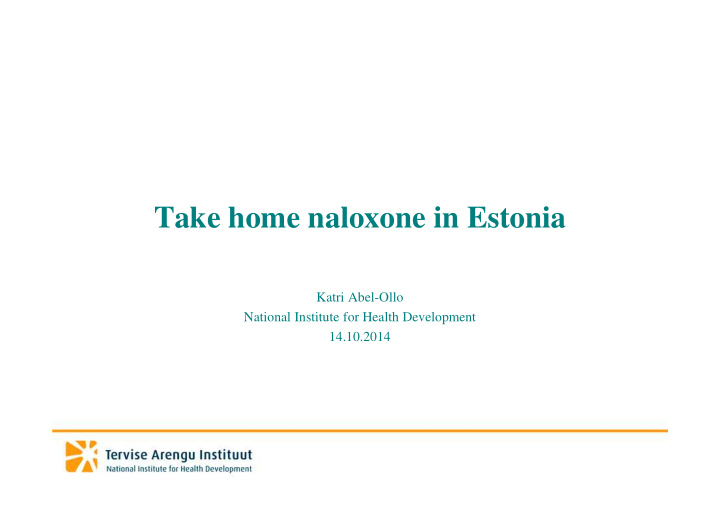



Take home naloxone in Estonia Katri Abel-Ollo National Institute for Health Development 14.10.2014
Background information 400 170 300 133 123 Total 111 200 101 Female 18 152 67 13 15 120 Male 18 108 100 12 93 89 7 60 0 2008 2009 2010 2011 2012 2013 The mean age of persons who have died due to drug overdose has increased over the years. In 2002 the mean age was 24- years, then in 2013 32- years (the register of the causes of death, NIHD 2014). The majority (85%) of drug-related deaths are associated with synthetic drugs, in particular fentanyl and 3-methylfentanyl. (EKEI 2013)
Take home naloxone program •Program was launched in September 2013 Estonia by the National Institute for Health Development. Program operates in two region: East-Virumaa and Harjumaa. •The main purpose of the service is to reduce the number of fatal overdoses among IDUs due to the use of narcotic substances in Estonia. •The program educates IDUs and people close to them to recognize the overdose and administer naloxone to the person who has overdosed, and give first aid until the ambulance arrives.
Service description I • The provision of the service is carried out in cooperation with the health care providers and organizations providing harm reduction services in the region. • A health care provider trained by the National Institute for Health Development educates and hands over a naloxone-filled syringe to IDUs and people close to them after they have completed the training. • Naloxone only can be prescribed by a physician registered in register of health care professionals and the medication is only available in pharmacies stated by The National Institute for Health Development. • Harm reduction services advise and motivate customers to participate in the training and put together training groups.
Service description II • The description of services states how to carry out a training and how to put together training groups. The knowledge acquired during the training is the following: • Drugs and their effects, including interactions; • How overdose occurs; • Giving first aid to someone who has overdose (specific steps); • How to use pre-filled naloxone syringes; • The safe use of needles. Infectious diseases transmitted through injection; • Maintaining the used naloxone syringe and bringing it back to the service provider. NB! A person who has completed the training must complete a retraining course every three years.
Inclusion criterias and monitoring of the program The inclusion of naloxone program criteria is: A personalised patient of at least 16 years of age with the risk of opioid overdose A representative appointed by the personalised patient Methadone substitution therapy service provider Health care providers working in the syringe exchange Monitoring The participation of each person shall be documented. Everything related to the providing of a service shall be documented according to the forms developed for that specific reason. For each used naloxone injection, questions on the circumstances the naloxone was used shall be answered and each case shall be discussed.
Take home naloxone kit • The drug used in the program in Estonia is the PRENOXAD INJECTION. (naloxone hydrochloride 1mg/1ml solution for injection) and contains 2 ml naloxone hydrochloride 1 mg/ml.) • Inforamtion materials "How to act in case of an overdose?" and "Naloxone”
First results I 2013 (September–December) 2014 (January–June) Harju County East-Viru TOTAL Harju East-Viru TOTAL County County County Training courses: 13 7 20 37 39 76 Participants in the 56 33 89 223 242 465 training: including drug users 50 28 78 214 183 397 Persons receiving 56 33 89 223 240 463 Naloxone: including drug users 50 28 78 214 181 395 Repeated naloxone 8 7 15 35 22 57 prescriptions Table. Naloxone project report in September 2013 - June 2014. Source: The National Institute for Health Development 2014
First results II • In total, 554 participants received training and 552 naloxone syringe sets were given out during the period of September 2013 – June 2014. 72 repeated prescriptions were reported (one of them was reported as not intended for medical use). Most of the syringes were distributed to users of narcotic substances • There is an incearsing interest in expanding take home naloxone program to other harm reduction services and other regions. • Is police one target group in the future for the take home naloxone program in Estonia?
Recommend
More recommend